A whale and species on the brink. The end may be near for chronically entangled Snow Cone
Even as Hurricane Fiona pirouetted up toward New Brunswick Friday stirring up turbulence along the east coast, there was another story of turmoil — smaller, but nonetheless powerfully destructive — taking place in the waters south of Nantucket.
There, under the rising seas, a single North Atlantic right whale was stalwartly following her annual route toward the southern range of her habitat, struggling with what is her own storm of sorts — a maelstrom made of heavy, tangled ropes from traditional fishing gear.
The lone swimmer was Snow Cone, a 17-year-old, approximately 50-ton, chronically entangled, critically endangered right whale. She is among the last of her kind. Possibly the last of her bloodline.
Taking it slow for whales: NOAA eyes more restrictions to protect right whales, but it could be costly for PTown, ferries
The scientists who have been observing her for years now, and venturing out from time to time to help free her of the fishing gear she keeps getting wrapped in, fear she is dying.
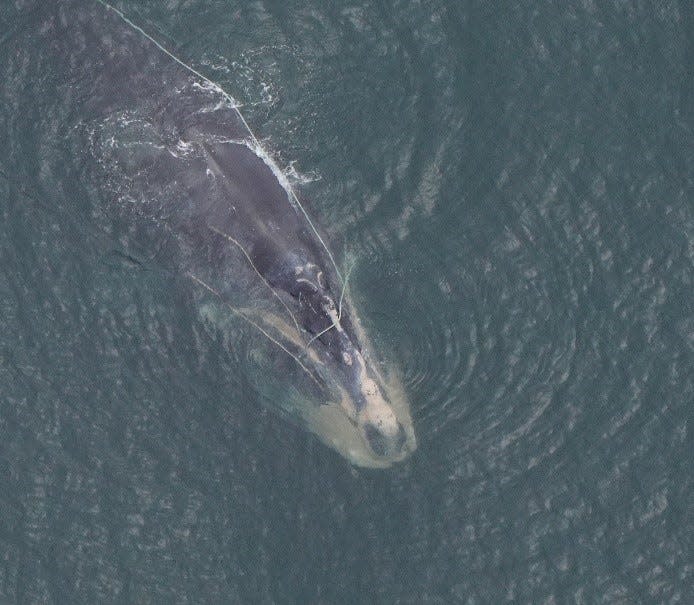
"Indications are that she is a whale that's in decline," said Scott Landry, director of the Marine Animal Entanglement Response Program at the Center for Coastal Studies in Provincetown. "There's every indication that her immune system is starting to falter."
Pale skin. Loss of weight. An abundance of whale lice on her body suggests reduced swim speed. These are all signals of severely declining health that can break the heart of even the most objective of scientists.
Whale tags go missing: Keep your eyes peeled on Cape Cod beaches and at sea
"The stories that people have and the connections researchers have to the whales is because you see them as a calf, you see them as a juvenile and you see them with their calves," said Heather Pettis, research scientist in the New England Aquarium’s Anderson Cabot Center for Ocean Life. "You’ve got multiple generations of whales around that you come to know. And you can’t help but get attached."
Snow Cone a 'poster whale' for the plight of the North Atlantic right whale
If there was ever a "poster whale" for the plight of the North Atlantic right whale, it would be Snow Cone, who is featured in the documentary film, "The Last of the Right Whales."
Right whales, among the last remaining large mammals on earth, exist on the cusp of extinction. Scientists estimate there are only 368 or fewer left.
Helping free entangled whales: Entangled humpback whale calf freed from rope near Chatham. Here's how they did it.
One of the greatest threats to these animals is entanglement in traditional fishing gear that relies on buoy lines and networks of rope. Another is getting struck by ocean-going vessels.
Snow Cone is now dealing with at least her fifth entanglement, picked up somewhere between the Gulf of St. Lawrence, Canada, where she was observed over the summer, and the waters just south of Nantucket last week.
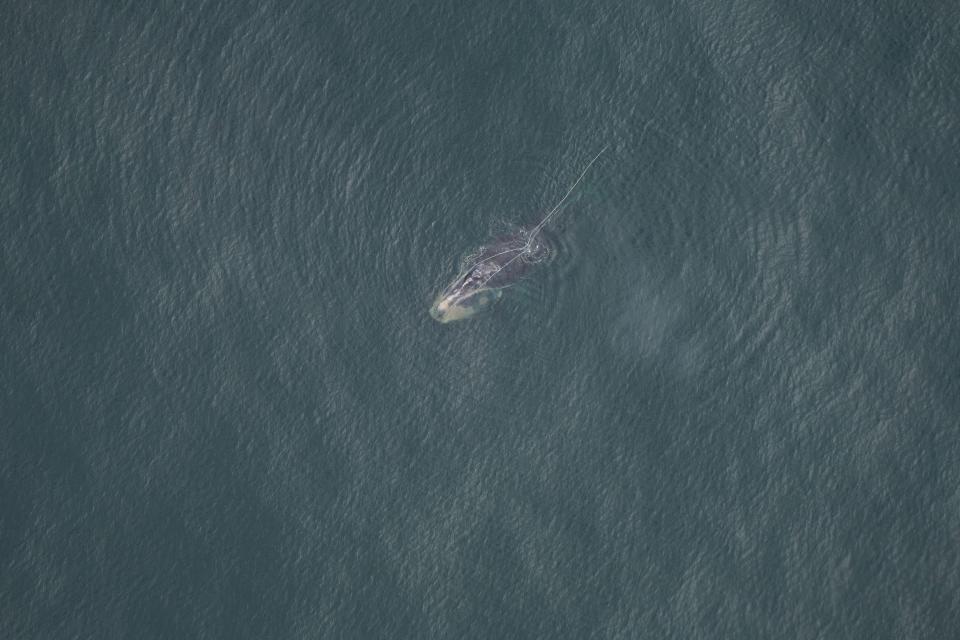
The new entanglement is not her only burden.
"She's now carrying two entanglements at once. For her to be so badly injured from her previous entanglement and then to get another one, this is quite extreme," said Landry. "People might say, what's the matter with this whale? But it's not the whales."
Herring River: Humpback whale dies after becoming stranded
Repeated entanglements are common, he said, noting that the majority of the right whales alive today have been entangled multiple times in their lives, more often than not suffering severe injuries that affect them for years. For too many, entanglement is eventually fatal.
"You can't blame the victim here," Landry said. "She's just living in an environment that's very dangerous for her."
Snow Cone sighted off Nantucket
Scientists with the New England Aquarium's aerial survey team spotted Snow Cone, who is listed as #3560 in their right whale catalog, about 15 nautical miles south of Nantucket on Sept. 21, entangled in the new fishing gear while still carrying previous gear scientists have been unable completely to remove.
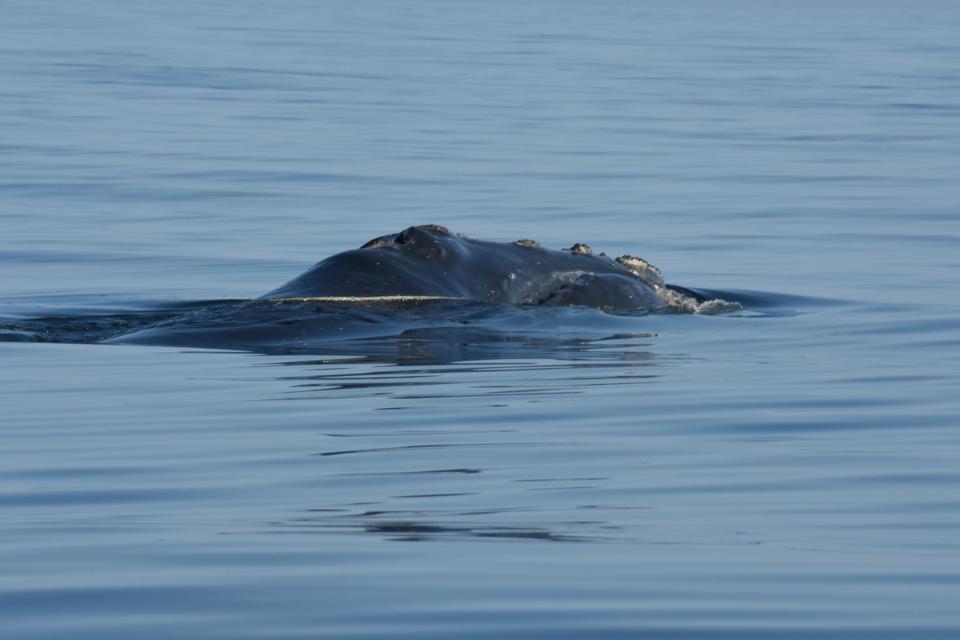
One of the research assistants on board was Sharon Hsu, who photographed Snow Cone at her previous entanglement sighting in March 2021. The scientist said she was shocked by the decline in the whale’s health.
“Eighteen months ago, there was hope that disentanglement efforts could remove enough of the gear and that would allow her to survive. Now, she’s covered in orange cyamids [whale lice]. She was moving so slowly, she couldn’t dive, she just sunk. She’s suffering,” Hsu said, expressing her fear that hope for Snow Cone is dwindling.
Senior aquarium scientist Philip Hamilton said it's difficult for the scientific community to see Snow Cone in the condition she's in.
Minke whale caught in fishing gear rescued off the coast of Plymouth
“Bearing witness to the pain and suffering of this whale is gut-wrenching,” he said. “Even worse is the realization that, with her imminent death, we will have lost the potential of as many as 30 future right whales being added to the species. We know several right whale family lines that have produced 25 to 30 progeny so far (calves, grand calves, great grand calves). The impacts of the loss of a single reproductive female gets amplified through time.”

Provincetown team prepared to help — 'We've never given up on a whale'
After sighting Snow Cone off Nantucket, the aquarium team alerted Landry's disentanglement team, but because of the time of day and distance to her sighting, a response could not be mounted immediately.
On Friday, Landry was in a difficult position, knowing there is a whale out there needing help, but unable to act because of the hurricane.
'This is how you die': One year later, Michael Packard recalls escape from whale
"The seas are already at 10 feet," he said, talking by phone Friday afternoon.
Disentangling whales requires calm waters, and so Landry and his team are having to sit tight. It could be days before the seas are calm enough, but Landry said there will be an outing — there will always be help coming — for as long as Snow Cone continues to rise to the surface to draw breath.
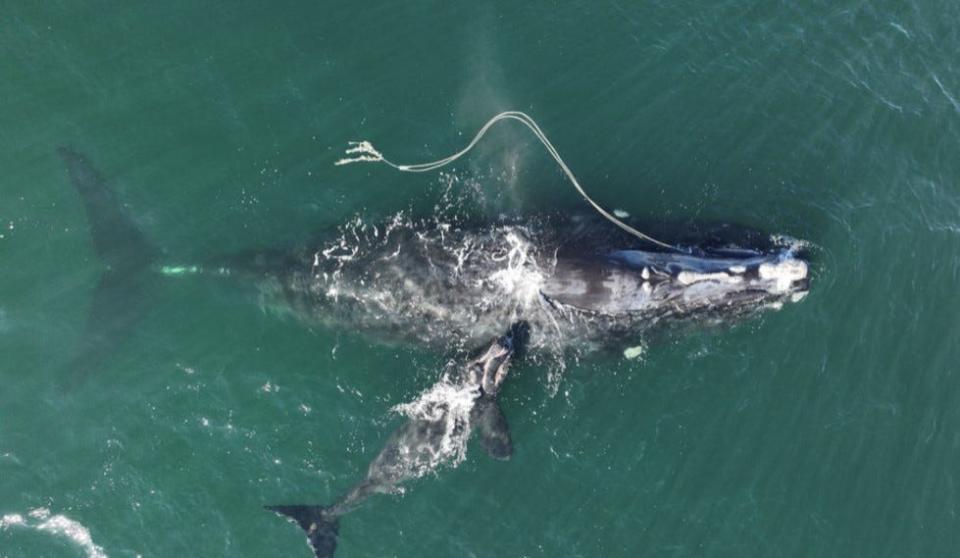
"We are going to be leaving from Provincetown to disentangle her if we can get the weather to work," he said.
Even though Snow Cone's condition is dire and there is a chance she won't survive her latest entanglement trial, Landry said he and others who work with the whales are always ready to do what they can, up until they can't anymore.
"In the work that we do we have to rely on optimism and hope," he said. "We've never given up on a whale. We definitely think it's worth our while to try to intervene and save her."
Disentangling whales is dangerous and difficult
Disentangling a whale is not easy work. Those who undertake the effort are literally putting their own lives at risk. Landry, who's done the work for 24 years and helped free about 150 whales, said one of his colleagues was killed during a disentanglement operation in 2017.
Homecoming:Pair of rehabbed sea turtles return to the ocean at West Dennis beach
While they are not violent animals, they are wild. They do feel pain, they do feel fear, and they will defend themselves when they're frightened. Every whale is different, from individual to individual, and from species to species, so scientists never know what to expect. But behaviors could include rolling, writhing and slapping flippers and flukes.
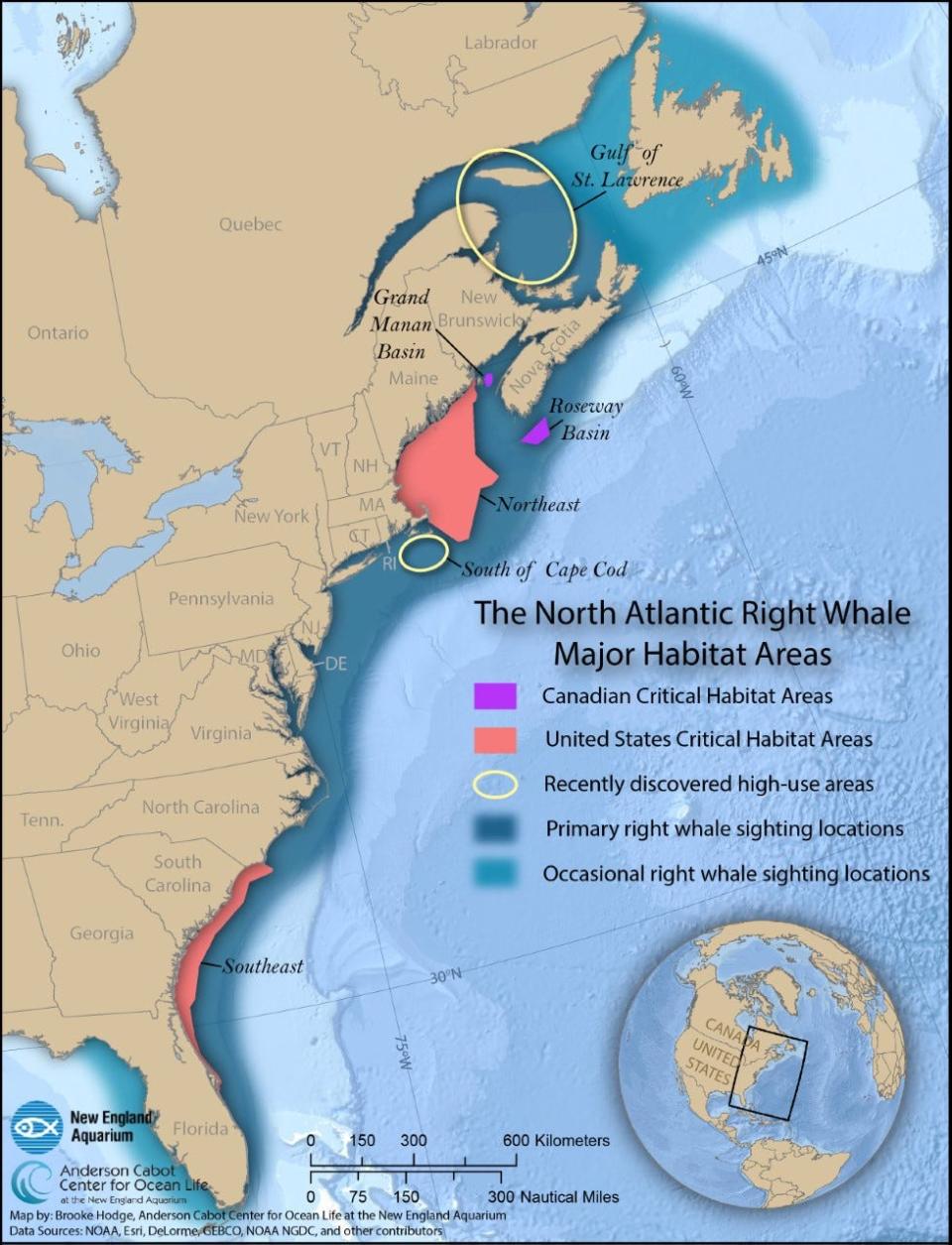
In Snow Cone's case, Landry said, "her flukes alone weigh just shy of a ton and her fluke is powered by many tons of very strong muscle."
"We have to disentangle an animal that is 50 tons. She doesn't want our help. Everything about her learning and her experience in life is that when boats approach you, you should try to get away. Plus she's feeling terrible," he said.
Solving a mystery: How researchers found missing North Atlantic right whales
On top of that, many of the things the scientists have to do to help are not as easy as cutting a rope and letting it fall away. Snow Cone has new gear tangled around her, but also has older rope that's become embedded in her skin. Some rope is wrapped around her upper jaw and has created a gap in her baleen.
"This is not veterinary care. We're not going to sedate a 50-ton animal, put her on a table and do surgery," Landy explained. "The sense of scale, I think, for the public is often hard to imagine. What does it mean to deal with a 50-ton animal? It's not only size but also power. Snow Cone is akin to a Mack truck and we're going to be in a small, inflatable boat, standing up while on the water."
Snow Cone is flexible enough that she could touch the tip of her jaw with her flukes, he said. It's not something the whales naturally do, but it's something they can do in the throes of reacting to perceived threats.
Meet Bubba and Kitt: the Woods Hole Science Aquarium's newest residents
"So it's just an enormous challenge," he said. "Folks who get into this kind of work tend to have had a lot of experience working with whales in the wild. It takes a lot of years and experience to understand what these animals are capable of."
Landy said he knows people who have been following Snow Cone's story are deeply upset about her current situation, as are the scientists. So while there are plans to go out and try to help, he wants people to temper their expectations.
"I want the public to realize that we are doing our best to get her help," he said. "This is the reality of what we do. This is deadly serious. We take it very seriously, we take her health very seriously. But we also have to realize we have to be alive to deal with the next entangled whale."
An urgent need for changes in order to help the whales
Snow Cone's story is a difficult one.
She's lost one calf to a boat strike. She's also lost her siblings and their offspring. While entangled, she gave birth to a second calf in December 2021 in the right whale calving grounds off the southeastern U.S. — the first right whale known to have successfully given birth while entangled.
That calf traveled with her as far as Cape Cod Bay in April this year, but by the time Snow Cone was sighted again in the Gulf of St. Lawrence in July, her calf was no longer with her. Snow Cone had grown thin, and may not have been able to produce enough milk for her calf. It remains unknown what happened to her baby, but considering right whale young stay with their mothers for 10 to 12 months, the answer likely isn't good.
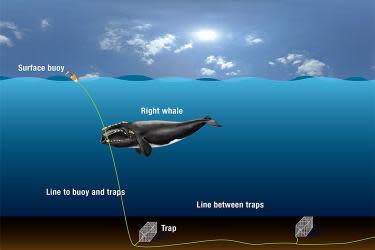
Unfortunately, the scientists say, Snow Cone's story is not unique.
“While horrific in and of itself, Snow Cone is not alone in her experience. More than 86% of right whales have experienced at least one and some individuals as many as eight entanglements, and the severity of these events has increased over time, " Pettis said.
Snow Cone’s entanglement is the fifth whale observed with attached gear this year, according to the New England Aquarium scientists, who say the situation underscores the urgent need for changes to the fishing industry — a shift to ropeless or “on demand” gear.
Toothy tales: A very incomplete history of sharks on Cape Cod
"The survival of this species demands that swift and broad actions be taken to prevent these events throughout their range," said Pettis.
With Snow Cone, she said, "we are watching one of the few remaining reproductive North Atlantic right whale females slowly die, and the deterioration and suffering that she has experienced is inexcusable."
Landry also stressed the need for stronger action to prevent more unnatural, premature right whale deaths owing to entanglements and vessel strikes. Snow Cone's situation, he said, "is a reminder to everyone that we need to get cooking."
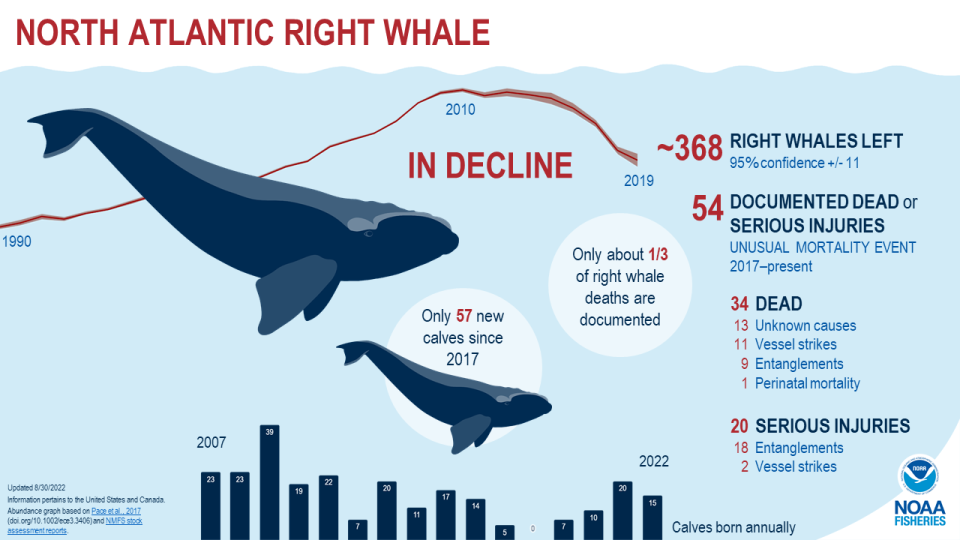
Reducing or removing vertical buoy lines, and replacing floating ropes with sinking ground lines can go a long way toward preventing entanglements, according to Landry.
"What we're dealing with is literally millions of buoy lines in the Gulf of Maine alone. People have been fishing this way for a long time," Landry said. "We do have to change and people are starting to realize that. But it's a human process and it takes time."
Those in the fishing industry are empathic, and are working with scientists to address the situation. Among them are the lobstermen of Massachusetts.
Crazy colored crustaceans: Crazy colored crustaceans: Rare lobsters wash ashore at Cape Cod markets
“The Lobster Foundation of Massachusetts and the Massachusetts Lobstermen’s Association remain committed to further reduce risk for right whales here in the Commonwealth," said Beth Casoni, executive director of the Massachusetts Lobstermen Association via email on Monday.
The Lobster Foundation, she noted, was awarded a Massachusetts Environmental Trust grant to help with the distribution of 300 coils of the weak (1,700 pounds) red and candy cane rope in early 2023. To date, the two organizations "have distributed over 1,000 coils of the 1,700 pounds of weak rope to the commercial lobstermen here in the Commonwealth over the last four years," she said.
The National Oceanographic and Atmospheric Administration's fisheries division has taken a number of steps already to help reduce the threat of entanglement to North Atlantic right whales, including seasonal fishing area closures and requiring fewer vertical buoy lines in trap/pot fishing.
'They're dying because we're killing them': Documentary hopes to help save right whales
And now scientists are actively working with fishermen and manufacturers to test “on-demand,” or ropeless fishing gear, "which will provide a future solution to prevent large whale entanglement," according to NOAA. The agency aims to roll out formal regulations in 2023.
Pettis said right whales frequently become entangled because they tend to traverse commercial fishing routes.
"They are very coastal. They’ve been dubbed the urban whale because for much of their migration they’re fairly close to shore," she said.
Right whales often feed at or near the surface with their mouths wide open to scoop up the zooplankton they eat, and they tend to roll when they've got a mouthful. This action is conducive to becoming easily entangled in any fishing lines in the feeding area.
The shark that wouldn't leave Cape Cod: A look back at Gretel, the reluctant great white
Pettis pointed out that regulating these lines, and requiring more "ropeless" fishing gear — which have float mechanisms that can be remotely activated or placed on timers — can not only help the right whales but other whales and sea turtles, too.
When it comes to stories like Snow Cone's, Pettis said it can be frustrating to see the public outcry come only after a whale is on death's doorstep.
"The public outcry is more to help the whale now. I wish people would be more vocal about preventing the entanglements. We know how to solve both issues of entanglement and boat strikes," she said. "If we can provide ocean habitats where the whales can be safe and do what they need to, the species will be fine. We know that recovery could happen, but not if we continue to put obstacles in their way."
While Snow Cone's story may seem to be one of extraordinary resiliency for having survived for so long with serious entanglement challenges, and even giving birth in the meantime, Pettis said from the perspective of the scientists it is not something to celebrate.
"When I look at her it’s horrifying, it’s not something to celebrate. That’s not resiliency," she said. "She’s being driven biologically to survive. We're putting these whales in a position where they’re just fighting for survival."
The National Oceanographic and Atmospheric Administration's fisheries division has taken steps to protect right whales including:
Implementing seasonal closures to fixed gear commercial fisheries in areas where right whales are known to aggregate
Requiring weak inserts or weak rope in fixed gear fisheries fishing to increase the likelihood that right whales can break free of buoy lines and gillnet panels
Requiring fewer vertical buoy lines in trap/pot fisheries (known as trawling up) in areas where right whales occur
Requiring sinking ground line (versus floating) between trap/pots and gillnet anchoring systems
Mandating gear marking to improve our understanding of where and how right whales become entangled
Increasing outreach and education
Improving the stranding response
Contact Heather McCarron at hmccarron@capecodonline.com.
Gain access to premium Cape Cod Times content by subscribing.
This article originally appeared on Cape Cod Times: New England scientists worry entangled right whale Snow Cone may die

